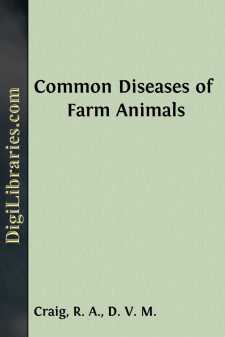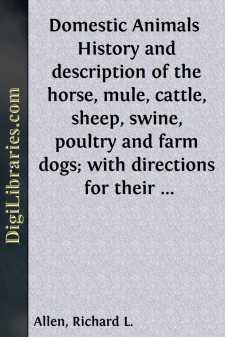Categories
- Antiques & Collectibles 13
- Architecture 36
- Art 48
- Bibles 22
- Biography & Autobiography 813
- Body, Mind & Spirit 142
- Business & Economics 28
- Children's Books 15
- Children's Fiction 12
- Computers 4
- Cooking 94
- Crafts & Hobbies 4
- Drama 346
- Education 46
- Family & Relationships 57
- Fiction 11829
- Games 19
- Gardening 17
- Health & Fitness 34
- History 1377
- House & Home 1
- Humor 147
- Juvenile Fiction 1873
- Juvenile Nonfiction 202
- Language Arts & Disciplines 88
- Law 16
- Literary Collections 686
- Literary Criticism 179
- Mathematics 13
- Medical 41
- Music 40
- Nature 179
- Non-Classifiable 1768
- Performing Arts 7
- Periodicals 1453
- Philosophy 64
- Photography 2
- Poetry 896
- Political Science 203
- Psychology 42
- Reference 154
- Religion 513
- Science 126
- Self-Help 84
- Social Science 81
- Sports & Recreation 34
- Study Aids 3
- Technology & Engineering 59
- Transportation 23
- Travel 463
- True Crime 29
Common Diseases of Farm Animals
by: R. A. Craig
Description:
Excerpt
CHAPTER I
GENERAL DISCUSSION OF DISEASE
Disease is the general term for any deviation from the normal or healthy condition of the body. The morbid processes that result in either slight or marked modifications of the normal condition are recognized by the injurious changes in the structure or function of the organ, or group of body organs involved. The increase in the secretion of urine noticeable in horses in the late fall and winter is caused by the cool weather and the decrease in the perspiration. If, however, the increase in the quantity of urine secreted occurs independently of any normal cause and is accompanied by an unthrifty and weakened condition of the animal, it would then characterize disease. Tissues may undergo changes in order to adapt themselves to different environments, or as a means of protecting themselves against injuries. The coat of a horse becomes heavy and appears rough if the animal is exposed to severe cold. A rough, staring coat is very common in horses affected by disease. The outer layer of the skin becomes thickened when subject to pressure or friction from the harness. This change in structure is purely protective and normal. In disease the deviation from normal must be more permanent in character than it is in the examples mentioned above, and in some way prove injurious to the body functions.
CLASSIFICATION.—We may divide diseases into three classes: non-specific, specific and parasitic.
Non-specific diseases have no constant cause. A variety of causes may produce the same disease. For example, acute indigestion may be caused by a change of diet, watering the animal after feeding grain, by exhaustion and intestinal worms. Usually, but one of the animals in the stable or herd is affected. If several are affected, it is because all have been subject to the same condition, and not because the disease has spread from one animal to another.
Specific Diseases.—The terms infectious and contagious are used in speaking of specific diseases. Much confusion exists in the popular use of these terms. A contagious disease is one that may be transmitted by personal contact, as, for example, influenza, glanders and hog-cholera. As these diseases may be produced by indirect contact with the diseased animal as well as by direct, they are also infectious. There are a few germ diseases that are not spread by the healthy animals coming in direct contact with the diseased animal, as, for example, black leg and southern cattle fever. These are purely infectious diseases. Infection is a more comprehensive term than contagion, as it may be used in alluding to all germ diseases, while the use of the term contagion is rightly limited to such diseases as are produced principally through individual contact.
Parasitic diseases are very common among domestic animals. This class of disease is caused by insects and worms, as for example, lice, mites, ticks, flies, and round and flat worms that live at the expense of their hosts. They may invade any of the organs of the body, but most commonly inhabit the digestive tract and skin....





